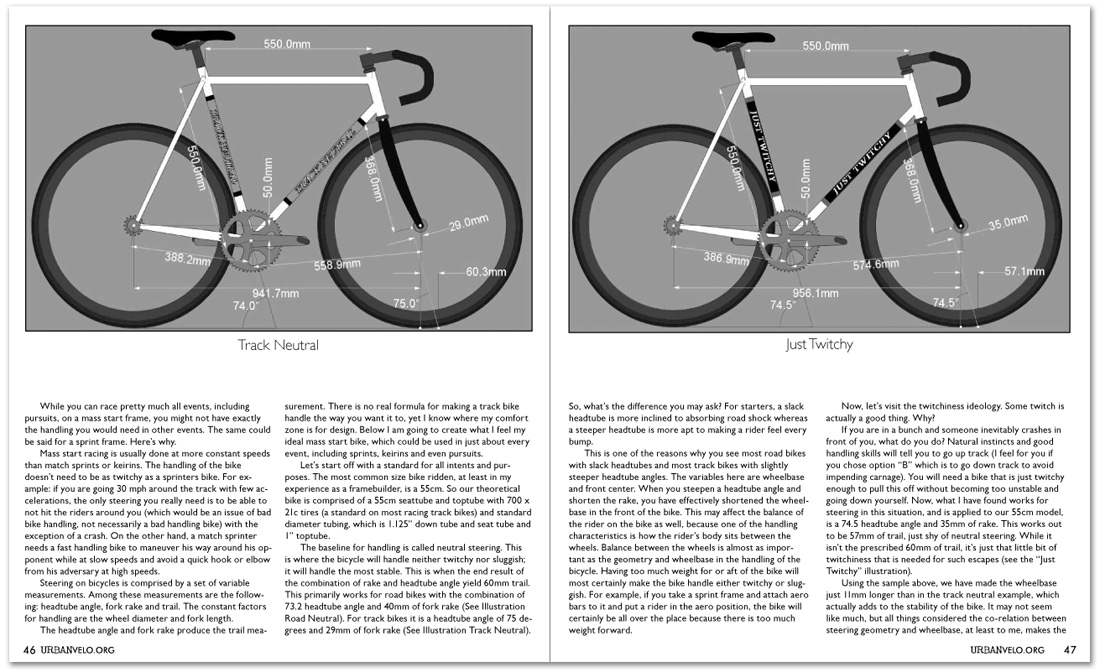
 |
|||
The Truth About Track Bike GeometryContinued While you can race pretty much all events, including pursuits, on a mass start frame, you might not have exactly the handling you would need in other events. The same could be said for a sprint frame. Here’s why. Mass start racing is usually done at more constant speeds than match sprints or keirins. The handling of the bike doesn’t need to be as twitchy as a sprinters bike. For example: if you are going 30 mph around the track with few accelerations, the only steering you really need is to be able to not hit the riders around you (which would be an issue of bad bike handling, not necessarily a bad handling bike) with the exception of a crash. On the other hand, a match sprinter needs a fast handling bike to maneuver his way around his opponent while at slow speeds and avoid a quick hook or elbow from his adversary at high speeds. Steering on bicycles is comprised by a set of variable measurements. Among these measurements are the following: headtube angle, fork rake and trail. The constant factors for handling are the wheel diameter and fork length. The headtube angle and fork rake produce the trail measurement. There is no real formula for making a track bike handle the way you want it to, yet I know where my comfort zone is for design. Below I am going to create what I feel my ideal mass start bike, which could be used in just about every event, including sprints, keirins and even pursuits. Let’s start off with a standard for all intents and purposes. The most common size bike ridden, at least in my experience as a framebuilder, is a 55cm. So our theoretical bike is comprised of a 55cm seattube and toptube with 700 x 21c tires (a standard on most racing track bikes) and standard diameter tubing, which is 1.125” down tube and seat tube and 1” toptube. The baseline for handling is called neutral steering. This is where the bicycle will handle neither twitchy nor sluggish; it will handle the most stable. This is when the end result of the combination of rake and headtube angle yield 60mm trail. This primarily works for road bikes with the combination of 73.2 headtube angle and 40mm of fork rake (See Illustration Road Neutral). For track bikes it is a headtube angle of 75 degrees and 29mm of fork rake (See Illustration Track Neutral). So, what’s the difference you may ask? For starters, a slack headtube is more inclined to absorbing road shock whereas a steeper headtube is more apt to making a rider feel every bump. This is one of the reasons why you see most road bikes with slack headtubes and most track bikes with slightly steeper headtube angles. The variables here are wheelbase and front center. When you steepen a headtube angle and shorten the rake, you have effectively shortened the wheelbase in the front of the bike. This may affect the balance of the rider on the bike as well, because one of the handling characteristics is how the rider’s body sits between the wheels. Balance between the wheels is almost as important as the geometry and wheelbase in the handling of the bicycle. Having too much weight for or aft of the bike will most certainly make the bike handle either twitchy or sluggish. For example, if you take a sprint frame and attach aero bars to it and put a rider in the aero position, the bike will certainly be all over the place because there is too much weight forward. Now, let’s visit the twitchiness ideology. Some twitch is actually a good thing. Why? If you are in a bunch and someone inevitably crashes in front of you, what do you do? Natural instincts and good handling skills will tell you to go up track (I feel for you if you chose option “B” which is to go down track to avoid impending carnage). You will need a bike that is just twitchy enough to pull this off without becoming too unstable and going down yourself. Now, what I have found works for steering in this situation, and is applied to our 55cm model, is a 74.5 headtube angle and 35mm of rake. This works out to be 57mm of trail, just shy of neutral steering. While it isn’t the prescribed 60mm of trail, it’s just that little bit of twitchiness that is needed for such escapes (see the “Just Twitchy” illustration). Using the sample above, we have made the wheelbase just 11mm longer than in the track neutral example, which actually adds to the stability of the bike. It may not seem like much, but all things considered the co-relation between steering geometry and wheelbase, at least to me, makes the |
|
|